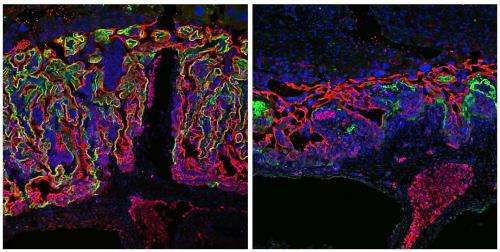Development of the placenta of a mouse The placental labyrinth forms the interface between the blood circulation of the embryo (bottom) and the mother (top). Two of its cell layers are immunofluorescence-stained in red and green, respectively. In the left image the labyrinth is normally developed. In the right image the labyrinth is compact and its branching is impaired, because the gene regulator Grhl2 was inactivated. Credit: Katharina Walentin/Copyright: MDC
During pregnancy, the mother supplies the fetus with nutrients and oxygen via the placenta. If placental development is impaired, this may lead to growth disorders of the embryo or to life-threatening diseases of the mother such as preeclampsia, a serious condition involving high blood pressure and increased urinary protein excretion. Now, Dr. Katharina Walentin and Professor Kai Schmidt-Ott of the Max Delbrück Center for Molecular Medicine (MDC) Berlin-Buch have discovered a new molecular signaling pathway which regulates the development of the placenta. Perturbations of this pathway in mice cause developmental defects of the placenta.
The study focused on the gene regulator grainyhead-like 2 (GRHL2), which the research group has been investigating for a several years. As Dr. Walentin and Professor Schmidt-Ott have now shown, this regulator plays a key role in the development of the placenta. In a previous study, Professor Schmidt-Ott and his team discovered that it regulates the differentiation of epithelial cells - they line the cavities and surfaces of structures throughout the body - in the mouse embryo.
In the current study, the researchers noted that GRHL2 is very active in the healthy placenta, especially in trophoblast cells, which are responsible for the development of the labyrinth. This placental labyrinth forms the interface between the blood circulation of the embryo and the mother. It ensures the exchange of nutrients and oxygen as well as the removal of embryonic metabolic end products. The trophoblast cells branch out to form the labyrinth, and they are accompanied by fetal blood vessels. Thereby, a large interface is created to facilitate the exchange of metabolites between mother and fetus.
In mice, when the researchers inactivated the gene regulator GRHL2 in the fetal part of the placenta and in the embryo, the development of the labyrinth was severely disrupted. In particular, the branching of the trophoblast cells and the migration of the fetal blood vessels into the placenta were impaired. When the researchers inactivated the gene regulator only outside the placenta in the embryo, the labyrinth developed normally. Using genome-wide analyses, the MDC researchers found that GRHL2 regulates a defined gene program. Components of this program are critically involved in the development of the placenta.
During their studies, which were funded by the German Research Foundation (DFG) and the Urological Research Foundation, the researchers additionally discovered that GRHL2 and its target genes also display activity in the human placenta. They hope that these findings could be significant for the understanding of developmental abnormalities of the placenta and related pregnancy disorders in humans.
More information: A Grhl2-dependent gene network controls trophoblast branching morphogenesis, Development 2015 142:1125-1136; DOI: 10.1242/dev.113829
Journal information: Development
Provided by Max Delbrueck Center for Molecular Medicine (MDC) Berlin-Buch



















